-
Posts
53 -
Joined
-
Last visited
Content Type
Profiles
Forums
Gallery
Events
Posts posted by Rat-Fink-A-Booboo
-
-
Hi USS frolick
Its the title of a 1966 film that is so unbelievably bad that it's quite good/funny.
It should have been called Rat Pfink AND Boo Boo but a typo got onto the posters and the film maker couldn't afford to put it right - the idea still makes me giggle. Oh, just bye the bye, Rat Pfink is a superhero - I'm sure you get the picture :-)
wishing everyone fair winds and a following sea
Don
-
-
-
Hi Druxey, Jaager, Allan, Jaxboat
Woah!
Thanks everybody - slammed on the anchors just in time by the sound of things

I'd love to plank directly onto the deck supports, but I don't trust them to be accurate. I figured that the false deck would find its own 'true' curves if fixed amidships.
The pinning and nailing sounds like the best option - the planking will have to wait and the scarfing and nibbing will just be a bit more fiddly around the waterways.
As always wishing you all fair winds and a following sea.
- mtaylor, Ryland Craze and druxey
-
 3
3
-
-
HI Druxey
Yes and it has no slots for the upper "top timber" bulwarks supports which the instructions say must be removed. Hence the false deck sits on the curved deck supports and runs right up to the waterway. The problem seems to me to be how to clamp the false deck to the curved supports whilst the glue cures and sets the camber and the sheer. i hope I'm making sense
Many thanks
-
Hi again folks
I omitted to mention that the bulwarks are 1 1/2 - 2 cm high and have to be gotten over in some way to clamp the deck down
-
Hi Folks
I have in mind a knotty problem. I am building Lynx by Panart. The model requires the building of the gun'ls and then removing the supports in order to accommodate the false deck. This is my first build and I am at a loss as to how to bend the false deck to fit taking into account both sheer and camber. Fortunately there is no tunblehome.
Do any of you wonderful people have any tips on how to do this?
Thanking you all in anticipation
Wishing you all a fair wind and following seas
Don
-
-
Hi there folks
Does any one know what kind of wood is best for the outer skin of planking if I want a slightly exaggerated (raised) surface grain. I intend painting my model (Lynx) black above the water but don't want it too smooth. The Lynx was hiding in the Chesapeake waterways when she was captured and I doubt she was done up like a show boat.
Perhaps there might be ways of raising the grain a little after sanding???
Thanking you all in anticipation
Don
-
Back from the heart hospital, but had a stroke in there - now blind on left side of both eyes. Boat-building's going to be a little slower now, but I ain't going to stop.
More pictures soon
Yes Popeye, this is my first build
Wishing you all fair winds and a following sea.
Don
-
hi Popeye
I Love this build - fascinating
-
Thanks Popeye - nice to know I might be in the right ball park
Just looking at a picture of the Manchester NH area in the fall - what a beautiful part of the world you live in
Off into hospital tomorrow to have some work done on the old clock, so the Lynx has been put to bed for a few days.
Finding the whole boat-building thing engrossing. My wife is getting sick of hearing about every little detail.
All the best to you and yours
-
I have taken this bulwark strake off and tried it again after realizing that I hadn't examined the plans properly, where there is a 1/1 representation of the curve of this plank. Doh!
Also reproduced here is my plan for narrowing the planks toward the bow.
I have also significantly re-modelled the poop and transom to be in line with the plans in Chappelle. This involved shortening the poop by about 1cm.
The new top bulwark looks like this - a much more plausible line, I think, and more in line with the drawings in Chappelle.
It will be noted that the top timbers do not match the line given in the plans. Not to worry, however, as they will be coming off before fitting the deck.
-
Bulkheads faired and first bulwark strake added.
I'm a little concerned about the stem to stern curve in the horizontal plane. Following the Gunwale supports the strake is flat between the bow and bulkhead 6 then there is a sharp curve and then then little curve from there to the stern.I'm not sure the hights of the bulwark supports are to be trusted. According to Chapelle there is only a very slight curve from stem to stern and very little variation along the length of the plank
Would my esteemed friends have any comments - like take it off and try it again?
-
-
Does anyone have any ideas what has been done here, particularly with the wonderful 'oak' below the waterline. Not just the wonderful coluor but the rough, weathered plank texture too. The model is of the Anne McKim built by Walter A Symonds in 1931 and is in the Addison Collection http://www.pa59ers.com/library/Addison/ships.html
- Canute, Archi and Mirabell61
-
 3
3
-
-
-
I am building (first build) Lynx, Mantua Panart. The hull is double planked and per the instructions each side will be 2.5mm thick. The keel, into which I am cutting the rabbet is only 5mm thick. Clearly this is not thick enough for all four planks to sit in their rabbets. Do any of you splendid folk have any advice.
I was thinking I would not take the first skin into the rabbet and sand the planks down to the barding line. Then only put the outer skin into the rabbet. This, however would probably mean single thickness only in the dead wood area at the stern. Any thoughts?
- mtaylor, Eddie and thibaultron
-
 3
3
-
Hi Stevinnie.
I hope you enjoy the build and that we can unravel some of the pitfalls.
Hi Juhu
I might take a trip to Greenwich and see what I can learn
I have seen a picture of a completed 'Lynx' which has really caught my imagination. I think it might inform my build as it goes along
Picture below.

The completed bow blocks reveal a more plausible bearding line. I think I should be able to infer the rabbet for the whole hull now.
- popeye the sailor, hexnut and coxswain
-
 3
3
-
Hi Popeye
Thanks for your encouragement
Best Don
-
Nice to hear from you Juhu
At this stage I'm referring to the drawings in Chapelle of Mosquidobit when her lines were taken off in 1816, and trying to make some sense of the kit plans in the light of those. Where the bearding and rabbet lines are concerned, the natural line followed by bending a flexible plank across the keel end of bulkheads 2, 3, and 4, and the top of the bow seems to me (in my ignorance) to be a reasonable assumption. This means there's work to be done on both bulkheads 1 & 2, and the two bow pieces before fairing can begin in earnest.
As this is a first kit for me, I can't really afford to get too bogged down in real "authenticity". I'll do my best and with the help of the wonderful folk on NRG I hope I'll make a reasonable job of it.
-
- coxswain, John Allen, Fright and 1 other
-
 4
4





Copper bottomed Baltimore Clipper?
in Nautical/Naval History
Posted
HI Folks
Does anyone out there know whether the Baltimore Clippers would have been copper bottomed. I can't find any reference to copper at all in 'Chapelle'. My assumption is that since copper clad hulls were available in 1807 - 1812 and that the ships were built for speed, a copper clad hull would make sense - but then, they were also supposed to be cheap.
Any thoughts most welcome
Wishing you all fair winds and a following sea.
Don